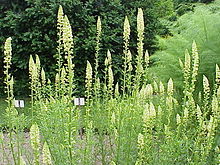Reseda (plant)
| Reseda | |
|---|---|
 |
|
| Reseda lutea (wild mignonette) | |
| Scientific classification | |
| Kingdom: | Plantae |
| (unranked): | Angiosperms |
| (unranked): | Eudicots |
| (unranked): | Rosids |
| Order: | Brassicales |
| Family: | Resedaceae |
| Genus: |
Reseda L. |
| Species | |
|
See text |
|
See text
Reseda (mignonette) is a genus of fragrant herbaceous plants native to the Europe, southwest Asia and North Africa, from the Canary Islands and Iberia east to northwest India. The genus includes herbaceous annual, biennial and perennial species 40–130 cm tall. The leaves form a basal rosette at ground level, and then spirally arranged up the stem; they can be entire, toothed or pinnate, and range from 1–15 cm long. The flowers are produced in a slender spike, each flower small (4–6 mm diameter), white, yellow, orange, or green, with four to six petals. The fruit is a small dry capsule containing several seeds.
Other common names include weld or dyer's rocket (for R. luteola), and bastard rocket.
Propagation is by seed, which is surface-sown directly into the garden or grass verge. The plant does not take well to transplanting and should not be moved after sowing.
Mignonette flowers are extremely fragrant. It is grown for the sweet ambrosial scent of its flowers. It is used in flower arrangements, perfumes and potpourri. A Victorian favourite, it was commonly grown in pots and in window-boxes to scent the city air. It was used as a sedative and a treatment for bruises in Roman times. The volatile oil is used in perfumery. The yellow dye was obtained from the roots of R. luteola by the first millennium BC, and perhaps earlier than either woad or madder. Use of this dye came to an end at the beginning of the twentieth century, when cheaper synthetic yellow dyes came into use.
...
Wikipedia
